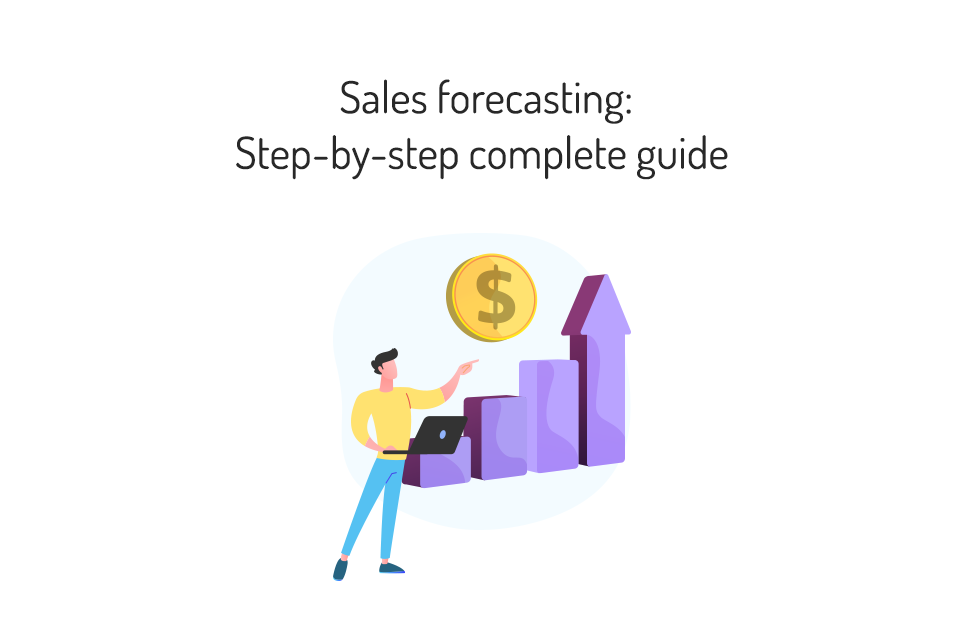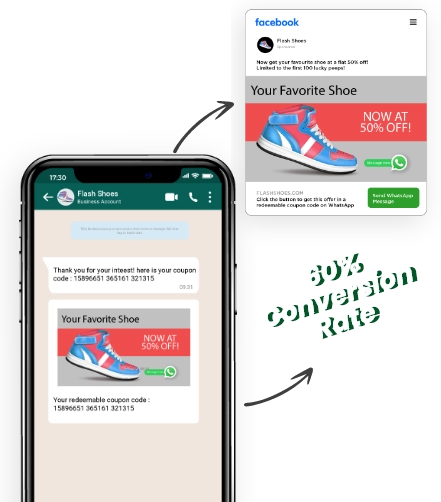Are you new to sales forecasting?
Or someone who is aspiring to make it big in a specific industry?
New entrepreneurs are always optimistic about the future of their company and want to do every right thing for their business. When it comes to details, most of us aren’t aware of what sales forecasting actually is? And how to predict future sales and how much money they’re going to make?
Sales forecasting is a crucial business exercise. Accurate sales forecasting allows you to make smarter decisions for your business. And if you are a sales manager, you’ll agree with me that inaccuracy may leave you running around circles. Right?
We have put together everything you need regarding sales forecasting for you to make intelligent decisions. Let’s get started.

What is sales forecasting?
A sales forecast is a projection of future revenue from sales. Forecasts for sales are often based on historical data, industry trends, and the present state of the sales pipeline. The sales forecast is used by businesses to estimate weekly, monthly, quarterly, and yearly sales totals. Your sales forecast should be like a weather forecast, it should be viewed as a plan to work from rather than a firm prediction.
Why is sales forecasting important?
Sales forecasting is important because it shows you how much money you can expect to make in a given period. The data in the sales forecast can be used to make informed decisions about your sales process.
This process helps you to identify potential problems and mitigate or at least reduce the impact that might entail. Let’s say for example: if your sales revenue begins to decline, you’ll be able to identify the root causes sooner, preventing further sales decline. You can make some improvements more quickly, such as changing your promotion strategies or training your sales representatives.
It’s difficult to stress how critical it is for a business to generate a reliable sales estimate. When executives can trust predictions, privately owned firms gain confidence in their operations. Like you wouldn’t step out to go to the beach or for a night out without checking the weather forecast, would you? Of Course not! So why would you want to plan your company’s fiscal year without the sales forecast?
Let’s take a look at an example: If you buy something from an e-commerce website, you get a delivery estimate, on which date you are gonna receive your order. But if you get your delivery two days or a week later, it affects your satisfaction as a customer and also decreases your willingness to purchase from the company again.
In both situations, sales forecasting is comparable. Sales projection aid in the planning of resources for shipping items, paying for marketing, hiring employees, and more. If your company’s sales forecasts aren’t on point, it can affect everything from price to product delivery to customers. Meanwhile, if forecasts are accurate, your company can make more strategic expenditures, from employing new developers to set up a new office dedicated to sales in a key new region.
What are the key objectives of Sales Forecasting?
Sales forecasting is one of the most important factors of every organization, be it a sales rep or the entire organization. It is used to estimate how your business numbers and toll free number might look like and how it lays a solid foundation for time and resource planning. A good sales prediction should contain a number of goals and objectives. Below are some of the crucial objectives that every sales manager should consider before sales forecasting:
Production
It’s one of the foremost objectives of sales forecasting, recognizing the amount of production. Sales forecasting is used by manufacturers to create initial estimates for material purchases and production levels. Let’s say there is an anticipated reduction in demand during the summer months, as well as a corresponding decrease in material cost which results in reduced demand, the organization may cut production levels and boost material purchases.
Budget
While sales forecasting predicts future sales, it also allows the owner to set a reasonable budget and make decisions about where and how much to spend. The owner can utilize the sales forecast to create a monthly static budget that includes wages, rental fees, and utilize it in order to retain valuable employees through times of low profit.
Staffing
During the peak time of the year, it often happens that the organization faces a lack of employees and that affects them adversely. The sales prediction can assist establish suitable employment levels for seasonal firms that see a big surge in demand only at specific seasons.
Investing and Investors
A sales projection can also assist business owners in obtaining extra financing unlike the current value of a firm, which is generally based on assets, the sales prediction shows potential investors what type of return on investment the company is expected to achieve. his is important to mention in an investor deck. A sales forecast that indicates future revenues in excess of the business’s current worth offers a compelling case for investing since investors may expect a better return on the investment.
What factors should you keep in mind when making sales forecasts?
Some of the key ingredients of sales forecasting are who, what, where, why, and How. Let’s get into the details to know more about these key ingredients and why they are important while making sales forecasts.
Who: Sales forecasts team makes their decision based on their prospects, who their prospects are. The projection will be more or less accurate depending on whether their prospects are real decision-makers or just merely influencers.
What: Sales forecasts are generally based on the specific products your organization intends to sell. In turn, this should be based on issues your prospects have raised and that your firm can answer in a unique way.
Where: Where will the actual products being used and sold? When salespeople come closer to the center of activity, they perceive improved accuracy.
Why: The must-ask question- why are the prospects or customers interested in buying products or services from your organization in the first place? Is there a compelling incident that has prompted them to think about it?
How: Factors influencing the decision of prospects or How the prospects tend to make decisions? You must reflect on how they’ve done it in the past to make a forecast of how they’re doing it now.
Who are the ones responsible for sales forecasting?
There is multiple personnel in an organization who are responsible for the sales forecasting and the criteria on which the sales forecast is based:
Product leaders: The ultimate responsibility of product leaders is to set a date for when some items will be ready for purchase.
Sales leaders: They make sure that their team meets the target and also set the number that the team will deliver. It includes three-level managers and forecasts differ depending on their level of seniority.
First-level managers anticipate collections of opportunities whereas third-line managers make an overall projection based on a large number of numbers and conventional closure rates.
Sales reps: The responsibility of every sales rep is to report their numbers to their managers.
Now let’s take a look at ways with which you can improve the accuracy of your sales forecasting:
Count on complete and accurate sales reports
First, gather your previous year’s sales data. Sales figures alone are insufficient, you must ensure that it is complete and accurate. You can use your previous sales data as a starting point, then consider all of the factors that could help you increase your sales.
Find out if any new trends in the market are relevant to your business, new market opportunities, rising demand for your products and services.
Consider factors that may reduce your sales. Are there any new entrants in your industry? Are there any regulatory changes that may have an impact on your business’s offerings? If so, then you need to reduce your expectations.
Choose the right software
You will find numerous forecasting tools in the market, however, it is up to you to select the best software for your needs. You’ll need access to both qualitative and quantitative data so you can keep track of the increase or decrease of numbers as well as the reasons for those increases or decreases.
Automation is another feature of good forecasting software. Marketing and sales automation solutions assist you in tracking and storing data, eliminating the chance of human mistakes and boosting prediction accuracy.
Keep track of the factors affecting your sales
There are several internal and external factors you should keep an eye on when forecasting sales:
Internal factors
Hires and fires
When the number of your sales reps decreases due to layoffs, your sales revenue may suffer. However, as the number of your sales reps grows, you can anticipate revenue growth in the following period.
Policy modifications
Changes in sales regulations or policies can also have an impact on your income. For example, if you implement a four-month commission clawback, your income will certainly decrease. Because your sales representatives will only sell to the most qualified prospects. However, as the number of prospects increases, your profits will also rise.
Relocation of business
When you relocate your business from one location to another, you’ll need to make some adjustments. Your sales reps will need time to familiarize themselves with the new area and build their pipeline, so you have to prepare yourself for a temporary drop in income.
External factors
Changes in the competitive environment
It should come as no surprise that what your competitors do can have an impact on your earnings. Therefore, it is critical to understand what they do to increase their sales. This allows you to devise better strategies for recouping your sales revenue.
Market variations
Make sure you’re always aware of what your potential customers want. You must determine whether or not there is still a high demand for your service or product. If demand is low, you might consider adding a trending item to your sales, discounting your service or product, or using bundling techniques.
Seasonality
At certain times of the year, your customers may be more likely to purchase. Parents, for example, tend to make more purchases during the back-to-school season and spend less the rest of the year.
Economic changes
When the economy is doing well, buyers are more likely in their businesses. When the economy is weak, however, the sales cycle usually takes longer, and buyers require more consideration for each purchase.
Focus on demand not supply
Don’t just think about the supply of your product or service when forecasting sales. Concentrate on-demand first, then consider supply. You can also make a supply and demand graph to better visualize the market dynamics. This will assist you in providing the appropriate inventory. You’ll be able to avoid both shortages and excess inventory, which will allow you to save more money.
Let’s say for example, that your organization provides 200 computers per month, but data indicates that there will be a demand for 300 computers the following month. As a result, by forecasting ahead of time, you’ll have enough time to order more computers to meet this demand.
Plan a weekly forecasting meeting
It’s critical to meet with your sales team regularly to ensure you’re on track with your goals and to gain insight into what’s coming in the coming weeks. Simultaneously, keep an eye out for any red flags that could significantly deviate your final numbers from the original forecast.
Your weekly forecast meetings are critical because they help you identify issues before they become larger problems and encourage your team to brainstorm ideas for improvements. They’re also a great way to get your teams on the same page.
Using any of these forecasting techniques correctly takes practice, but it will help you be more objective with your sales process and look ahead. And remember, although accurate data is important the aim is for valuable, not perfect information.
Sales forecasting is crucial when it comes to maintaining a profitable business and keeping customers happy and satisfied. Whereas poor sales forecasting and planning may have far-reaching negative effects on a company’s operations, development, and reputation. In addition, a lack of revenue from poor sales performance will hit a company’s bottom line and mean that when it comes to producing financial documents such as an income statement, the figures declared will be well down on what was originally expected or forecasted.
Let me take you through the case studies on some of the prominent brands and how sales forecasting plays a major role for them.
Successful sales forecasting examples
IKEA
IKEA’s management strategy is based on a proprietary inventory system that provides logistics managers with point-of-sale data and also how much merchandise arrives into the store via direct shipment and distribution centres. By using this data, the logistics manager correctly estimates sales for the next several days and orders items to meet the expected demand. If the sales data does not match the project turnover for the day, the manager counts the goods in stock manually.
This is a good example of forecasting technology assisting business logistics, with a manual method as a safety net to assure perfect accuracy.
ZARA
ZARA follows the approach of designing, manufacturing, distributing, and selling clothes within a two-week period, which is called just-in-time production. So how are they so flexible in production?
They retain a substantial portion of production in-house, allowing them to be more flexible in their production cycle and have full control over their supply chain and manufacturers.
Inappropriate and unsuccessful sales forecasting
Nike
You don’t need me to tell you about this reputable brand, just the name itself is sufficient to recognize the global domination it has. But Nike lost $100 million worth of sales in 2001 as reported by the company. How? The brand deployed demand-planning software without properly testing it resulting in an oversupply of low-selling shoes and a shortage of popular Air jordans which led to the firm losing $100 million.
In the above case, Nike suffered a setback while attempting to adopt a new strategy too quickly. While demand and sales forecasting are critical for anticipating sales and inventory management. Before implementing any new system, it should be thoroughly tested and analyzed.
Walmart
Walmart is known for being accurate and technologically advanced, but due to poor forecasting, it had a major out-of-stock problem in store back in 2013. Lack of shelf space and mismanagement inventory was the main reason behind it. Products were available in the warehouse of Walmart but there weren’t enough employees to transport them to the shelves.
In this case, cost-cutting efforts resulted in a bad customer experience for many, which might have been prevented if demand had been forecasted appropriately.
The bottom line
Accurate sales forecasting is clearly difficult because the results will always differ slightly from what was expected. However, with clean sales data and the right methods, you can generate nearly perfect sales forecasts.
When a CRM is used instead of a spreadsheet, sales forecasting is far more accurate. It includes everything from how well demand generation efforts are functioning to how well your prospect phone calls are landing.
Whatever sales forecasting techniques you employ, keep in mind that you are not limited to just one. Use multiple forecast methods to get a complete picture of your sales strategy. So what are you waiting for? Choose the one that will be the most beneficial to your company and begin implementing them.





